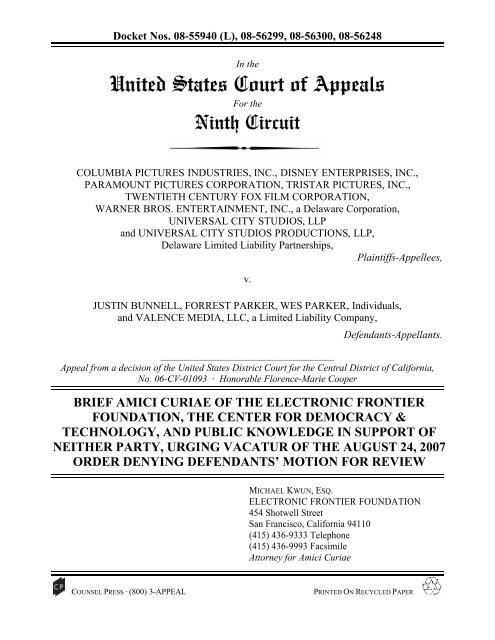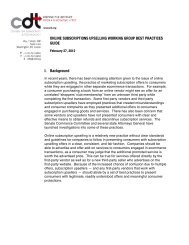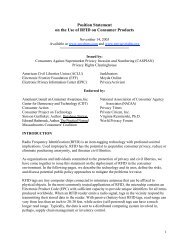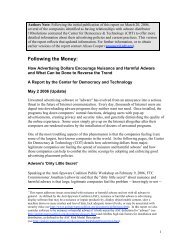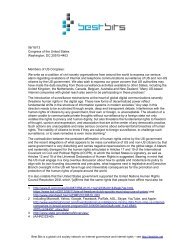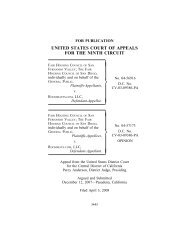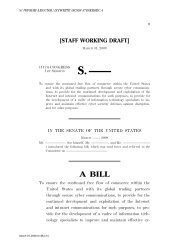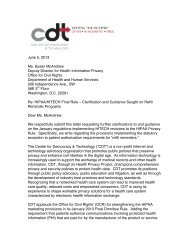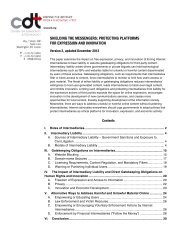20090212 Amicus Brief.pdf - Electronic Frontier Foundation
20090212 Amicus Brief.pdf - Electronic Frontier Foundation
20090212 Amicus Brief.pdf - Electronic Frontier Foundation
Create successful ePaper yourself
Turn your PDF publications into a flip-book with our unique Google optimized e-Paper software.
Docket Nos. 08-55940 (L), 08-56299, 08-56300, 08-56248<br />
In the<br />
United States Court of Appeals<br />
For the<br />
Ninth Circuit<br />
COLUMBIA PICTURES INDUSTRIES, INC., DISNEY ENTERPRISES, INC.,<br />
PARAMOUNT PICTURES CORPORATION, TRISTAR PICTURES, INC.,<br />
TWENTIETH CENTURY FOX FILM CORPORATION,<br />
WARNER BROS. ENTERTAINMENT, INC., a Delaware Corporation,<br />
UNIVERSAL CITY STUDIOS, LLP<br />
and UNIVERSAL CITY STUDIOS PRODUCTIONS, LLP,<br />
Delaware Limited Liability Partnerships,<br />
Plaintiffs-Appellees,<br />
v.<br />
JUSTIN BUNNELL, FORREST PARKER, WES PARKER, Individuals,<br />
and VALENCE MEDIA, LLC, a Limited Liability Company,<br />
Defendants-Appellants.<br />
_______________________________________<br />
Appeal from a decision of the United States District Court for the Central District of California,<br />
No. 06-CV-01093 · Honorable Florence-Marie Cooper<br />
BRIEF AMICI CURIAE OF THE ELECTRONIC FRONTIER<br />
FOUNDATION, THE CENTER FOR DEMOCRACY &<br />
TECHNOLOGY, AND PUBLIC KNOWLEDGE IN SUPPORT OF<br />
NEITHER PARTY, URGING VACATUR OF THE AUGUST 24, 2007<br />
ORDER DENYING DEFENDANTS’ MOTION FOR REVIEW<br />
COUNSEL PRESS · (800) 3-APPEAL<br />
MICHAEL KWUN, ESQ.<br />
ELECTRONIC FRONTIER FOUNDATION<br />
454 Shotwell Street<br />
San Francisco, California 94110<br />
(415) 436-9333 Telephone<br />
(415) 436-9993 Facsimile<br />
Attorney for Amici Curiae<br />
PRINTED ON RECYCLED PAPER
CORPORATE DISCLOSURE STATEMENT<br />
Pursuant to Rule 26.1 of the Federal Rules of Appellate Procedure,<br />
Amici Curiae the <strong>Electronic</strong> <strong>Frontier</strong> <strong>Foundation</strong>, the Center for Democracy &<br />
Technology, and Public Knowledge (collectively, “Amici”) state that none of<br />
Amici have a parent corporation and that no publicly held corporation owns<br />
10% or more of the stock of any of Amici.
TABLE OF CONTENTS<br />
TABLE OF AUTHORITIES ................................................................................. ii<br />
INTRODUCTION ..................................................................................................1<br />
I. STATEMENT OF INTEREST OF AMICI...................................................3<br />
II. SUMMARY OF ARGUMENT ....................................................................4<br />
III. ARGUMENT................................................................................................6<br />
A. Although discovery orders are reviewed for an abuse of<br />
discretion, a decision based on an error of law is per se<br />
an abuse of discretion..........................................................................6<br />
B. RAM data is transient data essential to the functioning<br />
of virtually every digital device...........................................................6<br />
C. The Server Log Data Order is inconsistent with the mandate<br />
that “discovery of electronically stored information stand[]<br />
on equal footing with discovery of paper documents”.........................8<br />
D. Server data in RAM is not electronically “stored” information .........10<br />
1. The use of the term “stored” in “electronically stored<br />
information” imposes a requirement of some degree<br />
of permanence.........................................................................11<br />
2. Case law interpreting the “fixation” requirement<br />
under the Copyright Act does not inform the meaning of<br />
“stored” under the Federal Rules of Civil Procedure...............13<br />
E. Treating data in RAM as ESI is not workable ...................................14<br />
IV. CONCLUSION ..........................................................................................17<br />
CERTIFICATE OF COMPLIANCE.....................................................................17<br />
DECLARATION OF SERVICE...........................................................................18<br />
i
CASES<br />
TABLE OF AUTHORITIES<br />
Alexander v. FBI,<br />
194 F.R.D. 305 (D.D.C. 2000)....................................................................10<br />
Anheuser-Busch, Inc. v. Natural Beverages Distribs.,<br />
69 F.3d 337 (9th Cir. 1995)...........................................................................2<br />
Apple Computer, Inc. v. Formula Int’l, Inc.,<br />
594 F. Supp. 617 (C.D. Cal. 1984)................................................................7<br />
Cartoon Network LP, LLLP v. CSC Holdings, Inc.,<br />
536 F.3d 121 (2d Cir. 2008)........................................................................14<br />
Convolve, Inc. v. Compaq Computer Corp.,<br />
223 F.R.D. 162 (S.D.N.Y. 2004).................................................................16<br />
MAI Systems Corp. v. Peak Computer, Inc.,<br />
991 F.2d 511 (9th Cir. 1993).................................................................13, 14<br />
Northern Sec. Co. v. United States,<br />
193 U.S. 197 (1904)......................................................................................1<br />
Paramount Pictures Corp. v. Replay TV,<br />
No. CV 01-9358, 2002 WL 32151632 (C.D. Cal. May 30, 2002) ...............10<br />
State of California v. Campbell,<br />
138 F.3d 772 (9th Cir. 1998).........................................................................6<br />
United States v. Berberian,<br />
767 F.2d 1324 (9th Cir. 1985).......................................................................6<br />
ii
STATUTES AND RULES<br />
17 U.S.C. § 101 ....................................................................................................13<br />
17 U.S.C. §§ 106–123...........................................................................................14<br />
Fed. R. App. P 29(a) ...............................................................................................3<br />
Fed. R. Civ. P 26...................................................................................................15<br />
Fed. R. Civ. P 26(f).....................................................................................5, 15, 16<br />
Fed. R. Civ. P 34............................................................................................passim<br />
Fed. R. Civ. P 34(a) .......................................................................................passim<br />
Fed. R. Civ. P 34(b) ..............................................................................................11<br />
OTHER AUTHORITIES<br />
8A CHARLES A. WRIGHT, ARTHUR R. MILLER, & RICHARD L. MARCUS,<br />
FEDERAL PRACTICE AND PROCEDURE § 2210 (2d ed. 1994) .........................10<br />
BARRON’S DICTIONARY OF COMPUTER AND INTERNET TERMS 295<br />
(7th ed. 2000)..............................................................................................12<br />
Clayton L. Barker & Philip W. Goodin, Discovery of <strong>Electronic</strong>ally<br />
Stored Information, 64 J. Mo. Bar 12, 14 (Jan.–Feb. 2008).........................16<br />
James Boyle, Intellectual Property Policy Online: A Young Person’s Guide,<br />
10 HARV. J. L. & TECH. 47, 90 (1996) ...........................................................7<br />
Kristen J. Mathews, Note, Misunderstanding RAM: Digital Embodiments<br />
and Copyright, 1997 B.C. INTELL. PROP. & TECH. F. 41501 ..........................7<br />
MELVILLE B. NIMMER & DAVID NIMMER, NIMMER ON COPYRIGHT § 8.08[A][1]<br />
(Matthew Bender 2005) ..............................................................................13<br />
iii
MICROSOFT COMPUTER DICTIONARY 332 (5th ed. 2002) .......................................12<br />
Niels Schaumann, Copyright Class War, 11 UCLA ENT. L. REV. 247 (2004) .........8<br />
R. Anthony Reese, The Public Display Right: The Copyright Act’s<br />
Neglected Solution to the Controversy Over RAM Copies,<br />
2001 U. ILL. L. REV. 83...............................................................................13<br />
THE SEDONA CONFERENCE, THE SEDONA PRINCIPLES: BEST PRACTICES,<br />
RECOMMENDATIONS & PRINCIPLES FOR ADDRESSING ELECTRONIC<br />
DOCUMENT PRODUCTION 8 (Jonathon M. Redgrave et al. eds., 2004)..........10<br />
WEBSTER’S NEW WORLD COMPUTER DICTIONARY 350 (9th ed. 2001) ..................12<br />
iv
INTRODUCTION<br />
This brief addresses the August 24, 2007 Order Denying Defendants’<br />
Motion for Review (the “Server Log Data Order”), ER 57–62, which itself<br />
followed Defendants’ Objections to and Motion for Review of Order Regarding<br />
Server Log Data. The Server Log Data Order reached an important question of first<br />
impression: Does digital data that exists only temporarily in a computer’s random<br />
access memory (“RAM”) qualify as “electronically stored information” (“ESI”)<br />
subject to preservation and production under Rule 34 of the Federal Rules of Civil<br />
Procedure? The district court, in error, answered that question “yes.” Amici ask this<br />
Court to vacate that order.<br />
Hard cases make bad law. 1 Defendants stand accused of enabling, inducing,<br />
and profiting from widespread copyright infringement. Concluding that Defendants<br />
had engaged in willful spoliation of evidence, the district court granted Plaintiffs’<br />
motion for terminating sanctions, entered Defendants’ default, and ultimately<br />
entered a massive default judgment against Defendants.<br />
The central issue on appeal is the district court’s December 13, 2007 Order<br />
Granting Plaintiffs’ Motion for Terminating Sanctions (the “Terminating Sanctions<br />
Order”). Excerpts of Record (“ER”) 27–42. Amici, however, express no view on<br />
whether the district court properly found that Defendants’ conduct during<br />
1 See Northern Sec. Co. v. United States, 193 U.S. 197, 364 (1904) (Holmes,<br />
J., dissenting).<br />
1
discovery was “obstreperous”; that Defendants engaged in “widespread and<br />
systematic efforts to destroy evidence”; that the resulting prejudice to Plaintiffs<br />
“weighs strongly in favor of terminating sanctions”; and “no lesser sanctions [than<br />
terminating sanctions] would be appropriate or effective.” ER 41; Anheuser-Busch,<br />
Inc. v. Natural Beverages Distribs., 69 F.3d 337, 348 (9th Cir. 1995) (discussing<br />
factors that must be considered prior to ordering terminating sanctions).<br />
Instead, Amici limit their arguments to the Server Log Data Order. The<br />
district court concluded that data in RAM qualifies as ESI, and ordered Defendants<br />
to record and produce extensive data about customers’ conduct that previously had<br />
been held only temporarily in RAM. ER 47–51. If followed by other courts, the<br />
district court’s ruling would create an unusual and onerous distinction between<br />
how discovery addresses “old fashioned” documents versus electronic information.<br />
Virtually every business in the United States relies on digital technologies<br />
for all kinds of communications. And virtually every function carried out by those<br />
technologies depends on and results in the temporary creation of RAM data that is<br />
not ordinarily retained. The data that travels through RAM could potentially<br />
include every keystroke and mouse click that a user makes, inadvertently accessed<br />
web pages, and digital telephone conversations. Thus, the Server Log Data Order<br />
threatens actual and potential litigants with the spectre of having to capture and<br />
2
compile an avalanche of RAM data that would otherwise be automatically<br />
overwritten in the ordinary course of computer processing.<br />
Neither the text of the Federal Rules of Civil Procedure nor the purpose<br />
behind the 2006 amendments that address ESI dictate this outcome. The Server<br />
Log Data Order should be vacated.<br />
I. STATEMENT OF INTEREST OF AMICI<br />
Amici file this brief pursuant to Rule 29(a) of the Federal Rules of Appellate<br />
Procedure, with the consent of all parties.<br />
The <strong>Electronic</strong> <strong>Frontier</strong> <strong>Foundation</strong> (“EFF”) is a non-profit, membership-<br />
supported civil liberties organization working to protect consumer interests,<br />
innovation and free expression in the digital world. As technologists, innovators,<br />
consumers and litigators, EFF and its over 14,000 dues-paying members have a<br />
strong interest in promoting fair and sensible rules for electronic discovery.<br />
The Center for Democracy & Technology (“CDT”) is a non-profit public<br />
interest group that seeks to promote free expression, individual liberty and<br />
technological innovation on the open, decentralized Internet. CDT advocates<br />
balanced policies that support the democratizing potential of new digital<br />
technologies and media. CDT believes that the discovery ruling below could harm<br />
the development and deployment of new digital technology, especially within<br />
companies and government agencies that are frequently parties to lawsuits.<br />
3
Public Knowledge (“PK”) is a Washington, D.C. based not-for-profit public<br />
interest advocacy and research organization. PK promotes balance in intellectual<br />
property law and technology policy to ensure that the public can benefit from<br />
access to knowledge and the ability to freely communicate and innovate in the<br />
digital age. PK has a strong interest in ensuring that the rules that apply to<br />
electronic discovery do not unjustifiably shift this balance and result in harm to<br />
the public.<br />
II. SUMMARY OF ARGUMENT<br />
The district court’s Server Log Data Order, issued less than four months<br />
before the court granted Plaintiffs’ motion for terminating sanctions, erroneously<br />
held that data held in RAM is ESI within the meaning of the 2006 amendments to<br />
the Federal Rules of Civil Procedure.<br />
The district court’s analysis runs contrary to a central intent of the 2006<br />
amendments: to design discovery rules that favor neither analog nor digital<br />
information. The holding that RAM is ESI creates an insupportable distinction in<br />
the scope of discovery that depends solely on whether information is managed<br />
using an analog or digital device. Far from putting electronic discovery on equal<br />
footing with traditional discovery, treating RAM as ESI would create a two-tier<br />
system of discovery that runs contrary to the intent of the law, and would impose<br />
unprecedented and cumbersome burdens on litigants.<br />
4
Indeed, the district court’s interpretation effectively reads the “S” out of<br />
“ESI.” Information in RAM is not “stored” in the sense intended by Rule 34,<br />
which refers to information stored in a “medium,” see FED. R. CIV. P. 34(a), not<br />
information in volatile memory.<br />
Although the district court suggested that the Server Log Data Order was a<br />
narrow order, see ER 41, its fundamental misreading of the phrase “electronically<br />
stored information,” if allowed to stand, has broad implications that threaten to<br />
mislead other courts and sow uncertainty for counsel. The scope of ESI defines<br />
parties’ obligations from the outset of each case. See FED. R. CIV. P. 26(f).<br />
Erroneously interpreting ESI to include data that exists solely in RAM could<br />
increase the burdens imposed by electronic discovery beyond any reasonable<br />
limits.<br />
Although this brief takes no position on the question of materiality, the<br />
Server Log Data Order may well have been part of the basis of the later<br />
Terminating Sanctions Order. See ER 40–41 (discussing prior discovery rulings<br />
against Defendants, and relying upon “further examination of the history of this<br />
case”). Accordingly, as part of its review of the Terminating Sanctions Order, this<br />
Court should evaluate whether the district court erred in its Server Log Data Order<br />
(and for the reasons herein should hold that it did), and then address the<br />
Terminating Sanctions Order in light of the erroneous prior order. And even if this<br />
5
Court concludes that the Server Log Data Order was not material to the<br />
Terminating Sanctions Order, it should nonetheless address the Server Log<br />
Data Order so that district court’s erroneous analysis does not mislead other courts<br />
and litigants wrestling with their electronic discovery obligations.<br />
III. ARGUMENT<br />
A. Although discovery orders are reviewed for an abuse of<br />
discretion, a decision based on an error of law is per se<br />
an abuse of discretion.<br />
Trial courts have wide latitude in controlling discovery, and on appeal a<br />
discovery ruling is reviewed for an abuse of discretion. State of California v.<br />
Campbell, 138 F.3d 772, 779 (9th Cir. 1998). But where a trial court bases its<br />
decision on an erroneous conclusion of law, it abuses its discretion. See United<br />
States v. Berberian, 767 F.2d 1324, 1324 (9th Cir. 1985).<br />
B. RAM data is transient data essential to the functioning<br />
of virtually every digital device.<br />
To understand the implications of the Server Log Data Order, it is crucial to<br />
understand the role that RAM plays in digital devices. Virtually every computer<br />
and digital device employs transient RAM “buffers” to hold both data and<br />
applications while data processing is carried out. Those RAM buffers are generally<br />
not used to store or record data; rather, they constitute a working area where data<br />
and applications are manipulated during a computing process. For example, as a<br />
6
user types at her keyboard, every stroke (including those that are immediately<br />
deleted as “typos”) is momentarily represented in RAM, where it is processed by<br />
software that is also held in RAM, before being sent to the computer’s display.<br />
Due to the sheer volume of data processed through RAM, that data is constantly<br />
overwritten by new data during the course of a computer system’s operations,<br />
sometimes within fractions of a second. See James Boyle, Intellectual Property<br />
Policy Online: A Young Person’s Guide, 10 HARV. J. L. & TECH. 47, 90 (1996)<br />
(“RAM is volatile; it is constantly rewritten while the computer is being used”).<br />
Indeed, the very purpose of having RAM is so that data can exist temporarily for<br />
processing without being stored in a medium such as a magnetic drive or an optical<br />
disc.<br />
Thus, RAM is inherently transient. “It is a property of RAM that when the<br />
computer is turned off, the copy of the program recorded in RAM is lost.” Apple<br />
Computer, Inc. v. Formula Int’l, Inc., 594 F. Supp. 617, 622 (C.D. Cal. 1984). And<br />
RAM is ubiquitous. 2 Almost all digital devices, including computers, cell phones,<br />
personal digital assistants (“PDAs”), compact disc players, fax machines, and<br />
2 See Kristen J. Mathews, Note, Misunderstanding RAM: Digital<br />
Embodiments and Copyright, 1997 B.C. INTELL. PROP. & TECH. F. 41501, 42<br />
(“Any electronic device that has anything more than an on-off switch usually<br />
contains some form [of] RAM.”).<br />
7
digital televisions, could not function without creating and manipulating data in<br />
RAM for a transitory period of time. 3<br />
Given the ubiquity of transient RAM data in digital technologies, courts<br />
should treat with skepticism claims that such data is equivalent to paper documents<br />
and, therefore, subject to preservation and production under Rule 34. Information<br />
that exists solely in ephemeral form in RAM is simply not the same as information<br />
that is “stored” for later retrieval.<br />
C. The Server Log Data Order is inconsistent with the mandate<br />
that “discovery of electronically stored information stand[]<br />
on equal footing with discovery of paper documents.”<br />
The district court’s analysis defies both common sense and the purposes of<br />
the 2006 amendments to the Federal Rules of Civil Procedure. The 2006<br />
amendments were intended to “confirm that discovery of electronically stored<br />
information stands on equal footing with discovery of paper documents.” FED. R.<br />
CIV. P. 34(a) advisory committee’s note. That is, ESI should be no less<br />
discoverable than non-electronic documents—but also no more.<br />
At least before the Server Log Data Order issued, no litigant would assume<br />
that erasing a whiteboard might violate a duty of preservation. Similarly, no court<br />
3 See generally Niels Schaumann, Copyright Class War, 11 UCLA ENT. L.<br />
REV. 247, 266 (2004) (“For it is not just software that is loaded into a computer’s<br />
RAM: all content accessed digitally is transferred to RAM before it is made<br />
perceptible to humans.”).<br />
8
would ask a litigant to record all telephone calls, to videotape all staff meetings,<br />
or to outfit every potential witness with a GPS tracking device in order to create<br />
a record of their locations at every moment.<br />
To be sure, objections based on burden, privacy, and attenuated relevance<br />
could be raised in those hypothetical situations. But the more basic point is that<br />
discovery simply does not reach such ephemera, even if highly relevant and easily<br />
collected (snapping photos of whiteboards is simple; many digital telephone<br />
systems can readily be configured to record calls; inexpensive video cameras now<br />
have massive storage capabilities; free programs allow one to track location via<br />
GPS features built into many modern cell phones). Yet that type of discovery is<br />
precisely what the Server Log Data Order contemplates, solely because the<br />
electronic equivalent of such ephemeral communications will necessarily involve<br />
the creation of a temporary snapshot that could, in theory, be preserved.<br />
The scope of Rule 34 should not vary based on whether information was<br />
created using digital or analog technology. The history and text of the revisions to<br />
Rule 34 do not contemplate this type of discrimination, nor do they endorse the<br />
radical expansion in the scope of discoverable documents that such a distinction<br />
would produce. Rather, the revisions were designed to ensure that civil discovery<br />
would remain neutral, so that the discoverability of information would not turn<br />
9
on the way it was maintained. See THE SEDONA CONFERENCE, THE SEDONA<br />
PRINCIPLES: BEST PRACTICES, RECOMMENDATIONS & PRINCIPLES FOR ADDRESSING<br />
ELECTRONIC DOCUMENT PRODUCTION 8 (Jonathon M. Redgrave et al. eds., 2004).<br />
D. Server data in RAM is not electronically “stored” information.<br />
It is well established that parties cannot be compelled to create new<br />
documents solely for their production. 4 The 2006 amendments to Rule 34 were not<br />
intended to undermine this principle. See FED. R. CIV. P. 34(a) advisory<br />
committee’s note. Instead, they were intended to put electronic documents “on<br />
equal footing” with traditional documents. Id. Thus, as amended, Rule 34(a)<br />
provides that a party may request documents or “electronically stored<br />
information—including writings, drawings, graphs, charts, photographs, sound<br />
recordings, images, and other data or data compilations stored in any medium from<br />
which information can be obtained . . . and which are in the possession, custody or<br />
control of the party upon whom the request is served.” FED. R. CIV. P. 34(a)<br />
(emphasis added).<br />
The district court’s Server Log Data Order effectively reads “stored” out of<br />
the above definition, thereby subjecting ephemeral digital information to discovery<br />
4 See 8A CHARLES A. WRIGHT, ARTHUR R. MILLER, & RICHARD L. MARCUS,<br />
FEDERAL PRACTICE AND PROCEDURE § 2210 (2d ed. 1994); Alexander v. FBI, 194<br />
F.R.D. 305, 310 (D.D.C. 2000); Paramount Pictures Corp. v. Replay TV, No. CV<br />
01-9358, 2002 WL 32151632, *2 (C.D. Cal. May 30, 2002).<br />
10
obligations that have no corollary in traditional discovery. The order then<br />
compounds the problem by substituting “fixation,” a concept drawn from copyright<br />
law, for Rule 34(a)’s requirement that the information be “stored in any medium.”<br />
1. The use of the term “stored” in “electronically stored<br />
information” imposes a requirement of some degree of<br />
permanence.<br />
There is no doubt that the phrase “electronically stored information”<br />
must be broadly construed. As the Advisory Committee noted, “the rapidity of<br />
technological change[] counsel against a limiting or precise definition of<br />
electronically stored information. . . . The rule . . . encompass[es] future<br />
developments in computer technology.” FED. R. CIV. P. 34(a) advisory committee’s<br />
note. The Advisory Committee plainly was seeking to avoid unnecessarily precise<br />
language that might accidentally read out of Rule 34(a) some as-yet unknown<br />
technology.<br />
But RAM was a well-known and ubiquitous technology at the time of the<br />
2006 amendments, and the Advisory Committee did not mention it even once in<br />
the 2006 amendments or the accompanying notes. Indeed, explaining the issues<br />
that might arise under the amendments, the Advisory Committee noted that<br />
“[u]sing current technology, for example, a party might be called upon to produce<br />
word processing documents, e-mail messages, electronic spreadsheets, different<br />
image or sound files, and material from databases.” FED. R. CIV. P. 34(b) advisory<br />
11
committee’s note. Surely if the amendments were intended to encompass RAM, it<br />
would have been mentioned in this discussion of “current technology”—or at least<br />
somewhere in the amendments and notes. Instead, the notes offer a myriad of<br />
examples—“word processing documents, e-mail messages, electronic<br />
spreadsheets, different image or sound files, and material from databases”—that all<br />
describe electronic information stored in non-volatile media.<br />
Further, the Advisory Committee’s notes to the 2006 amendments state that,<br />
as amended, Rule 34 “covers . . . information ‘stored in any medium’ . . . .” FED. R.<br />
CIV. P. 34(a) advisory committee’s note (emphasis added); see also FED. R. CIV. P.<br />
34(a) (Rule 34 applies to data “stored in any medium”). As used with computers, a<br />
medium is “material used for storage of information. Magnetic disks, tapes, and<br />
optical disks are examples of storage media.” 5 Unmentioned in that definition is<br />
RAM, or any other form of volatile memory. Instead, each is an example of a<br />
means of permanent storage that, unlike RAM, does not disappear at the flick of a<br />
power switch. The plethora of contrasting examples demonstrates that the omission<br />
5 BARRON’S DICTIONARY OF COMPUTER AND INTERNET TERMS 295 (7th ed.<br />
2000); see also MICROSOFT COMPUTER DICTIONARY 332 (5th ed. 2002) (“media” is<br />
“[t]he physical material, such as paper, disk, and tape, used for storing computerbased<br />
information”); WEBSTER’S NEW WORLD COMPUTER DICTIONARY 350 (9th<br />
ed. 2001) (“storage medium” is, “[i]n a storage device, the material that retains the<br />
stored information (such as the magnetic material on the surface of a floppy<br />
disk).”).<br />
12
of any mention of RAM in the advisory committee notes was no accident. Rather,<br />
it shows that the Committee, sensibly, did not consider volatile memory to be ESI.<br />
2. Case law interpreting the “fixation” requirement under<br />
the Copyright Act does not inform the meaning of “stored”<br />
under the Federal Rules of Civil Procedure.<br />
The district court erred in relying on MAI Systems Corp. v. Peak Computer,<br />
Inc., 991 F.2d 511 (9th Cir. 1993), 6 in support of its conclusion that data in RAM is<br />
sufficiently permanent to qualify as ESI. MAI Systems analyzed the fixation<br />
requirement in copyright law, not the scope of discovery. See 991 F.2d at 518–19.<br />
That definition is distinct, and serves a very different purpose, from Rule 34(a)’s<br />
requirement that electronic information be “stored.” Under the Copyright Act, a<br />
work is “fixed” when its “embodiment in a copy” is “sufficiently permanent or<br />
stable to permit it to be perceived, reproduced or otherwise communicated for a<br />
period of more than transitory duration.” 17 U.S.C. § 101. The concept of<br />
“storage” appears nowhere in the Copyright Act’s definition. The definition of<br />
fixation, moreover, must be understood as part of the detailed statutory scheme<br />
created by the Copyright Act, which grants exclusive rights to copyright owners,<br />
6<br />
Many copyright commentators have called into question the reasoning in<br />
MAI Systems. See, e.g., MELVILLE B. NIMMER & DAVID NIMMER, NIMMER ON<br />
COPYRIGHT § 8.08[A][1] (Matthew Bender 2005) (noting that the MAI System<br />
holding that RAM copies are fixed for copyright purposes has been “contentious”);<br />
see also R. Anthony Reese, The Public Display Right: The Copyright Act’s<br />
Neglected Solution to the Controversy Over RAM Copies, 2001 U. ILL. L. REV. 83,<br />
122–38.<br />
13
alanced by an extensive array of statutory limitations and exceptions.<br />
See 17 U.S.C. §§ 106–123.<br />
The federal discovery system rests on very different premises—it does not<br />
convey to a litigant any “exclusive right” to an adversary’s property, nor does it<br />
provide statutory “limitations and exceptions” to offset such an expansive grant of<br />
rights. The notion that the drafters of the 2006 amendments to Rule 34 drew their<br />
conceptions of “electronically stored information” from the Copyright Act is, to<br />
say the least, unusual. In short, the definition of “fixation” under the Copyright Act<br />
sheds no light on the meaning of “stored” in Rule 34(a). 7<br />
E. Treating data in RAM as ESI is not workable.<br />
In an attempt to cabin the effect of its order, the district court noted that:<br />
this decision does not impose an additional burden on any website<br />
operator or party outside of this case. It simply requires that the<br />
defendants in this case, as part of this litigation, after the issuance of a<br />
court order, and following careful evaluation of the burden to these<br />
defendants of preserving and producing the specific information<br />
requested in light of its relevance and the lack of other available<br />
means to obtain it, begin preserving and subsequently produce a<br />
particular subset of the data in RAM under Defendants’ control.<br />
ER 51. The district court’s order, however, is based on the holding that data in<br />
RAM is ESI. See ER 48–51. That holding has far-reaching repercussions.<br />
7 Moreover, MAI Systems did not hold that data in RAM is always fixed for<br />
purposes of copyright law. See Cartoon Network LP, LLLP v. CSC Holdings, Inc.,<br />
536 F.3d 121, 127–30 (2d Cir. 2008) (discussing MAI Systems).<br />
14
If RAM is ESI, then it follows that an accident of technological fate can<br />
have drastic and unexpected results on the scope of discovery in a case. For<br />
example, calls made over digital business phone systems, which are commonplace<br />
today, 8 or via Voice over Internet Protocol (“VoIP”) technology, a method of<br />
routing voice signals over the Internet, necessarily pass temporarily through RAM<br />
and could be retained through the use of simple software designed to log them.<br />
Under the reasoning of the Server Log Data Order, every call made on a digital<br />
phone system must be recorded by a party subject to a “litigation hold,” while calls<br />
made using analog phone systems need not. Similarly, a security system using<br />
digital video cameras would create voluminous quantities of ESI, while an analog<br />
system would not. 9 Surely a decision about the technology used to implement these<br />
sorts of systems should not have these effects. See FED. R. CIV. P. 34(a) advisory<br />
committee’s note (discovery of electronically stored information should “stand[]<br />
on equal footing” with traditional discovery).<br />
Moreover, at the outset of every case subject to the initial disclosure<br />
obligations of Rule 26, the parties must meet and confer regarding “any issues<br />
about disclosure or discovery of electronically stored information.” FED. R. CIV. P.<br />
8<br />
Even cordless telephones for residential use are often based on digital<br />
technology today.<br />
9<br />
Indeed, companies considering transitioning from an analog intercom to a<br />
digital system would then be well advised to weigh the possible increased costs of<br />
discovery.<br />
15
26(f). If RAM is ESI, this means that in addition to needing a data map of all<br />
potentially discoverable persistently stored electronic information, parties must<br />
keep track of all potentially relevant data they possess in RAM, so that they can<br />
meet their obligations under Rule 26(f). The difficulties companies have faced<br />
trying to map their persistent data have been enormous. See, e.g., Clayton L.<br />
Barker & Philip W. Goodin, Discovery of <strong>Electronic</strong>ally Stored Information, 64 J.<br />
Mo. Bar 12, 14 (Jan.–Feb. 2008) (discussing best practices for the preservation and<br />
collection of ESI). Requiring them to track ephemeral information as well raises<br />
this burden to an entirely new and untenable position. See Convolve, Inc. v.<br />
Compaq Computer Corp., 223 F.R.D. 162, 177 (S.D.N.Y. 2004) (holding that<br />
preservation of ephemeral data would require “heroic efforts far beyond those<br />
consistent with [a party’s] regular course of business.”).<br />
16
IV. CONCLUSION<br />
For the foregoing reasons, Amici urge the Court to hold that electronic data<br />
that exists only temporarily in RAM is not ESI, and to vacate the Server Log Data<br />
Order.<br />
Respectfully submitted,<br />
Date: February 12, 2009 s/ Michael Kwun<br />
Michael Kwun<br />
ELECTRONIC FRONTIER FOUNDATION<br />
454 Shotwell Street<br />
San Francisco, California 94110<br />
Telephone: (415) 436-9333<br />
Facsimile: (415) 436-9993<br />
Attorney for Amici Curiae<br />
CERTIFICATE OF COMPLIANCE<br />
Pursuant to Rule 32(a)(7)(B) of the Federal Rules of Appellate Procedure,<br />
I hereby certify that the foregoing brief complies with the 7,000-word volume<br />
limitation of Rule 29(d) of the Federal Rules of Appellate Procedure. I make this<br />
representation based upon the word count generated by the word processing<br />
software used to prepare this brief, which reflects that this brief contains 3,719<br />
words, excluding those portions exempted by Rule 32(a)(7)(B)(iii) of the Federal<br />
Rules of Appellate Procedure. The font used for this brief is Times New Roman<br />
in 14-point type.<br />
17
DECLARATION OF SERVICE<br />
I hereby certify that on February 12, 2009, I electronically filed the<br />
foregoing with the Clerk of the Court for the United States Court of Appeals<br />
for the Ninth Circuit by using the appellate CM/ECF system.<br />
I certify that all participants in the case are registered CM/ECF users and<br />
that service will be accomplished by the appellate CM/ECF system.<br />
s/ Stephen Moore<br />
18


